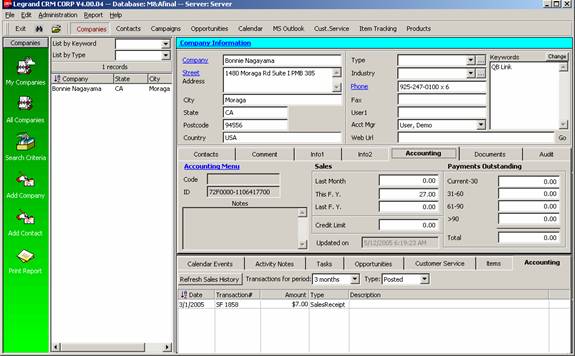
22 Nov Legrand CRM and QuickBooks Integration Summary
Legrand CRM and QuickBooks Integration Summary
While there is a detailed “How It Works” document available directly from Legrand CRM, this is our brief summary of what information is available from QuickBooks from within Legrand using the Accounting module.
The QuickBooks information is available from two different Accounting tabs with the Company.

The top (or upper) tab is available to all users even if they do not have access to the QuickBooks data base and/or the accounting module. The only requirement is that one user have the module, the data base is then updated for the others. That means that this information will only be as accurate as the “updated on” date on that tab. For users with access to the QuickBooks data file and who possess a licensed copy of the Accounting Module, the information will be updated in real time.
The bottom (or lower) tab is only for use by licensed users of the Accounting module. From the sales history, if the QuickBooks data file is open, it is possible to double click on the transactions to drill down into QuickBooks to see them.
In addition to the typical CRM feature of transferring the contact and company information, Legrand CRM takes integration much further.
On the top (or upper) tab:
- It is possible to manually enter the ID from QuickBooks or break the link
- The Sales summary for this month, this fiscal year, and last fiscal year are based on the cash or accrual preference as set in QuickBooks so the information is consistent between the two software programs
- The credit limit and notes are extracted from the customer list in QuickBooks for easy access in Legrand CRM even when the link to the QuickBooks data file is not present
- The payments outstanding use the same aging preference based on transaction date or due date
On the bottom (or lower) tab:
- The choices for transaction periods are – 1 month, 3 months, 6 months, 12 months, or all
- The choices for the transaction type are posted (includes invoices, sales receipts, and credit memos) or non-posted (estimates and sales orders)

